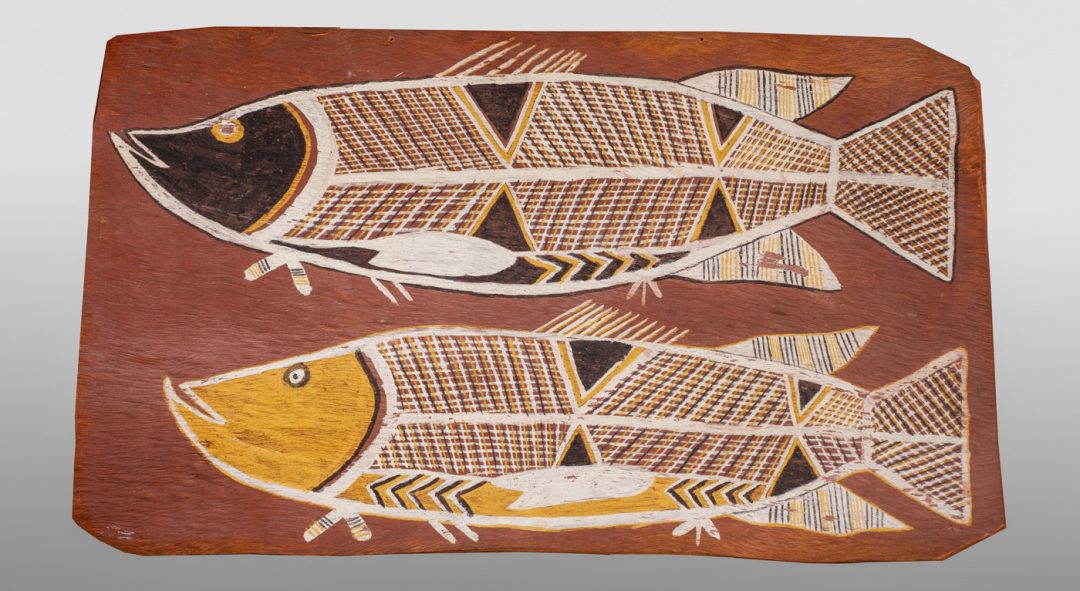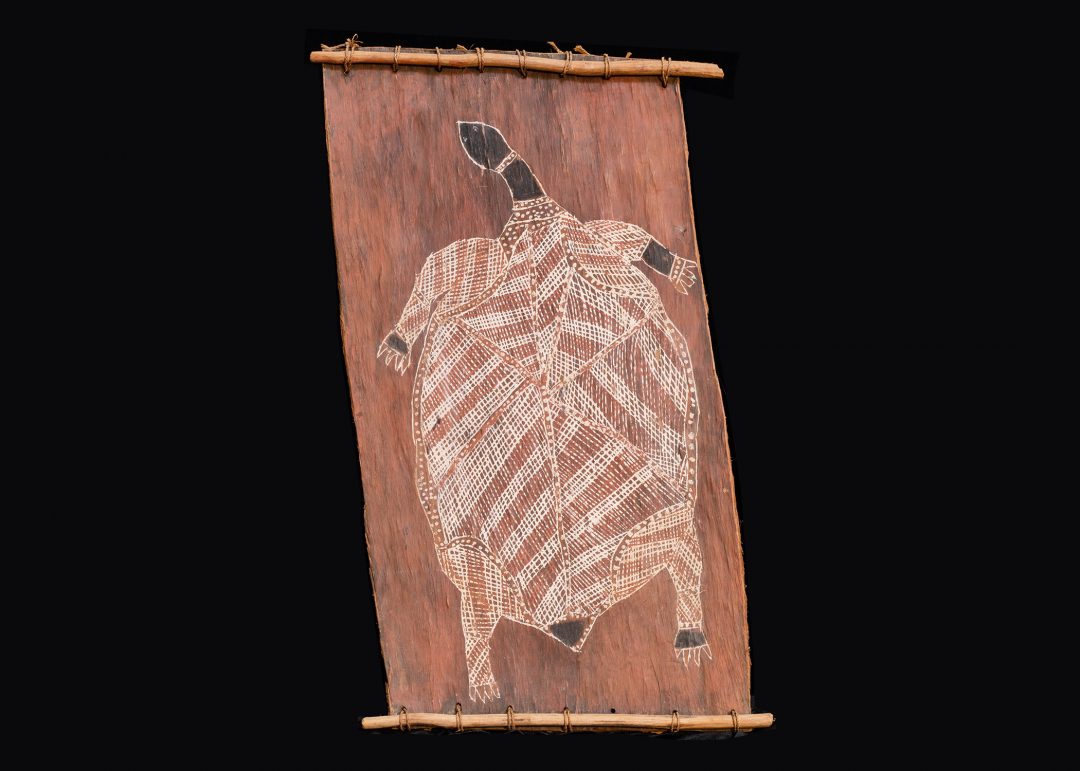Mungurrawuy was a senior Gumatji cultural leader, one of the Yirritja painters of the Yirrkala Church Panels (1963) and a signatory to the Aboriginal Bark Petition presented to the Australian Government in 1963. Amongst his children are the Aboriginal leader and land rights activist, Galarrwuy Yunupingu; recently deceased lead singer of Yothu Yindi, Mandawuy Yunupingu and the celebrated contemporary artists Gulumbu Yunupingu and Nyapanyapa Yunupingu.
This painting is in very good condition, framed behind glass.
The Dhimurru Aboriginal Corporation website, discusses a large stone display in Arnhem Land that depicts a prau
“Wurrwurrwuy is the Yolngu name of the area near Garanhan where there is a unique cluster of stone arrangements behind the rock-shelf. The area covered by these ‘stone pictures’ is approximately 70 metres by 80 metres. The outline pictures provide a window into the trade between the Yolngu of northeastern Arnhem Land and Indonesians that had existed for several centuries until 1907 when South Australia, which administered the Northern Teritory at the time, began using aggressive measures to collect customs duty. The Indonesians, mostly from Macassar in Sulawesi, came annually for trepang (dharripa, beche-de-mer or sea cucumber), turtle shell, and pearl shell to sell to Chinese traders. They sailed in their tri-masted praus on the northwest monsoon winds, and returned on the southeast trade winds. The Macassans acknowledged the Yolngu as owners of the land and the marine resources, and relations between Yolngu and Macassans were generally business-like and often cordial. Matthew Flinders, on his circumnavigation of Australia, encountered a fleet of Macassans near Cape Wilburforce in 1803 and spoke with Pobasso, the captain. Pobasso told him that two or three Yolngu sailed each year with the fleet to Macassar and that some had remained there.
The stone pictures were probably constructed by Yolngu elders toward the end of the nineteenth century, and in the 1960s clan leaders Mungurrawuy Yunupingu and Mawalan Marika told Campbell Macknight that the arrangements had been made by older members of their families so that future generations of Yolngu would know the history of the Macassan visits. Mungurrawuy’s father had actually been to Macassar.”
This painting is in very good condition, framed behind glass.
Mungurrawuy was a senior Gumatji cultural leader, one of the Yirritja painters of the Yirrkala Church Panels (1963) and a signatory to the Aboriginal Bark Petition presented to the Australian Government in 1963. Amongst his children are the Aboriginal leader and land rights activist, Galarrwuy Yunupingu; recently deceased lead singer of Yothu Yindi, Mandawuy Yunupingu and the celebrated contemporary artists Gulumbu Yunupingu and Nyapanyapa Yunupingu.
This painting is in very good condition, framed behind glass.
The Dhimurru Aboriginal Corporation website, discusses a large stone display in Arnhem Land that depicts a prau
“Wurrwurrwuy is the Yolngu name of the area near Garanhan where there is a unique cluster of stone arrangements behind the rock-shelf. The area covered by these ‘stone pictures’ is approximately 70 metres by 80 metres. The outline pictures provide a window into the trade between the Yolngu of northeastern Arnhem Land and Indonesians that had existed for several centuries until 1907 when South Australia, which administered the Northern Teritory at the time, began using aggressive measures to collect customs duty. The Indonesians, mostly from Macassar in Sulawesi, came annually for trepang (dharripa, beche-de-mer or sea cucumber), turtle shell, and pearl shell to sell to Chinese traders. They sailed in their tri-masted praus on the northwest monsoon winds, and returned on the southeast trade winds. The Macassans acknowledged the Yolngu as owners of the land and the marine resources, and relations between Yolngu and Macassans were generally business-like and often cordial. Matthew Flinders, on his circumnavigation of Australia, encountered a fleet of Macassans near Cape Wilburforce in 1803 and spoke with Pobasso, the captain. Pobasso told him that two or three Yolngu sailed each year with the fleet to Macassar and that some had remained there.
The stone pictures were probably constructed by Yolngu elders toward the end of the nineteenth century, and in the 1960s clan leaders Mungurrawuy Yunupingu and Mawalan Marika told Campbell Macknight that the arrangements had been made by older members of their families so that future generations of Yolngu would know the history of the Macassan visits. Mungurrawuy’s father had actually been to Macassar.”
This painting is in very good condition, framed behind glass.




